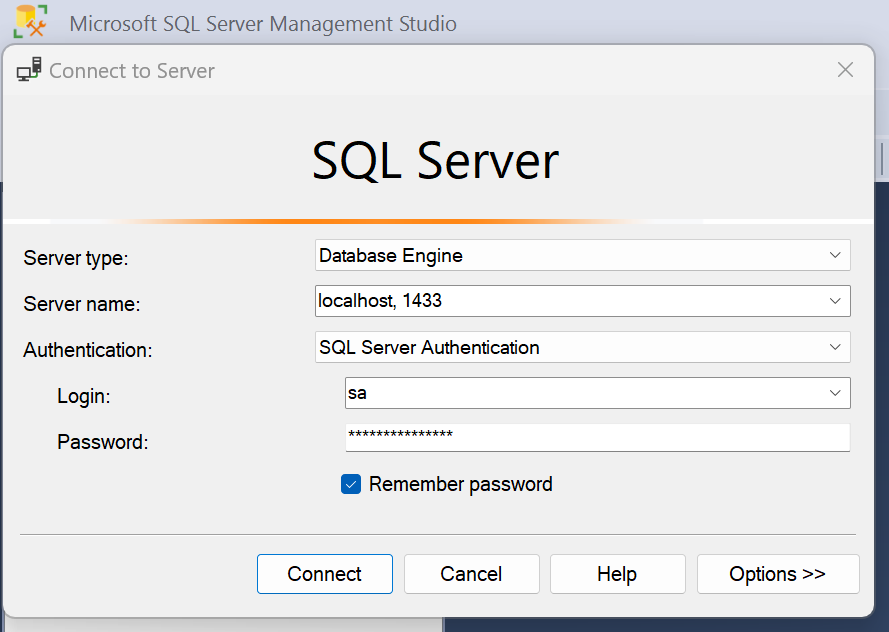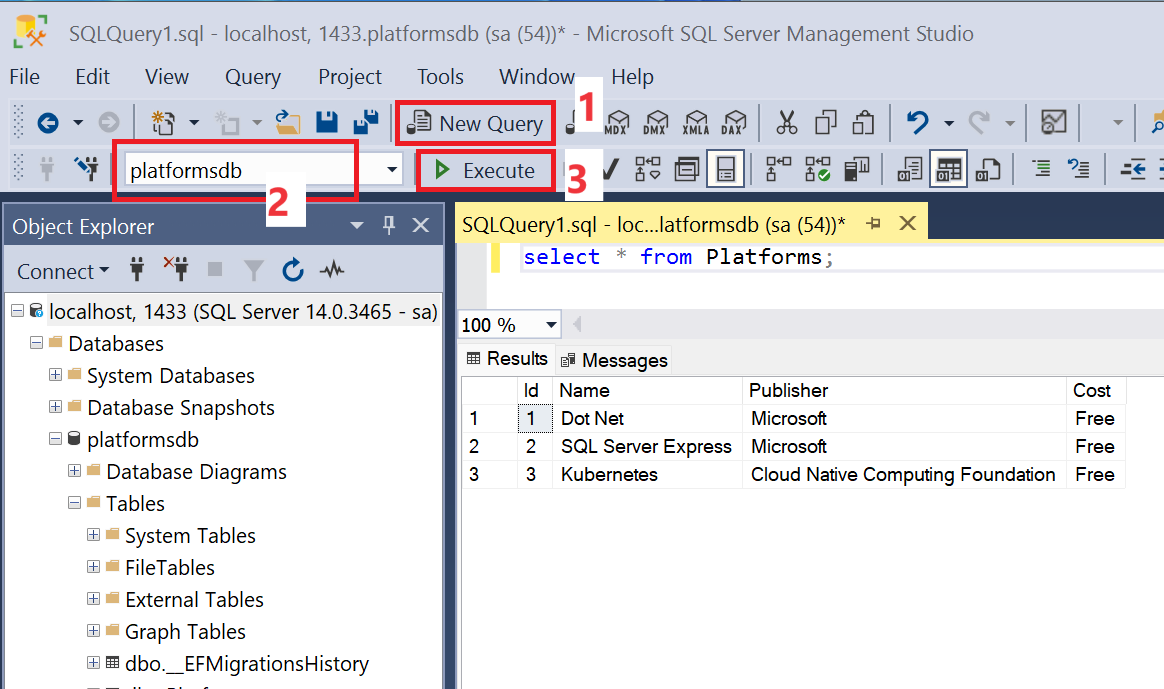part6 - Sql inside Kubernetes
- creating Sql Server inside Kubernetes
Terminology
- Persistent Volume Claim - we stake in our yaml file that we need some persistent storage
- Persistent Volume - this gets created under the hood. Ex Docker volume
- Storage Class - our local filesystem
Since were using just a local machine, we only need to set up the first step. In AWS etc. every part would need to be configured.
create the persistent volume claim
local-volumeclaim.yaml
# the persistent volume claim. Basically to stake out real memory for the SQl-DB
apiVersion: v1
kind: PersistentVolumeClaim
metadata:
name: mssql-claim
spec:
accessModes:
- ReadWriteMany
resources:
requests:
storage: 200Mi
- next create our claim: (
hosepathis the default filesystem that shows upkubectl get storageclass)
kubectl apply -f K8S/local-volumeclaim.yaml
kubectl get pvc
# NAME STATUS VOLUME CAPACITY ACCESS MODES STORAGECLASS AGE
# mssql-claim Bound pvc-263b1ab8-3f24-498f-b998-8aeea72f022b 200Mi RWX hostpath 57s
use kubernetes secrets to store the sensitive data (here sql-password)
kubectl create secret generic mssql --from-literal=SA_PASSWORD="pa55sword!"
create the ms-sql-server deploy
mssql-plat-depl.yaml
apiVersion: apps/v1
kind: Deployment
metadata:
name: mssql-depl
spec:
replicas: 1
selector:
matchLabels:
app: mssql
template:
metadata:
labels:
app: mssql
spec:
containers:
- name: mssql
image: mcr.microsoft.com/mssql/server:2017-latest
ports:
- containerPort: 1443
env:
- name: MSSQL_PID
value: "Express"
- name: ACCEPT_EULA
value: "Y"
- name: SA_PASSWORD
valueFrom:
secretKeyRef:
name: mssql ## this name came from the `kubectl create secret generic mssql --from-literal=SA_PASSWORD="password123!"`
key: SA_PASSWORD
volumeMounts:
## the path where in our dockercontainer the data is located at:
- mountPath: /var/opt/mssql/data
name: mssqldb
volumes:
- name: mssqldb
persistentVolumeClaim:
## this references the one we created in our: `local-volumeclaim.yaml`
claimName: mssql-claim
---
# the DB needs to be accessible for it's Service so we create a ClusterIP for it
apiVersion: v1
kind: Service
metadata:
name: mssql-clusterip-srv
spec:
type: ClusterIP
selector:
app: mssql
ports:
- name: mssql
protocol: TCP
port: 1433
targetPort: 1433
---
# the DB also needs to be accessible from outside the Kubernetes (at least for development)
# so we create a LoadbalancerService for it
apiVersion: v1
kind: Service
metadata:
name: mssql-loadbalancer
spec:
type: LoadBalancer
selector:
app: mssql
ports:
- protocol: TCP
port: 1433
targetPort: 1433
- then we fire it up:
- we can see how it shows up in colum:
EXTERNAL-IP=localhostso we should be able to reach there at port 1433
- we can see how it shows up in colum:
kubectl apply -f K8S/mssql-plat-depl.yaml
kubectl get services
# NAME TYPE CLUSTER-IP EXTERNAL-IP PORT(S) AGE
# commands-clusterip-srv ClusterIP 10.105.102.58 <none> 80/TCP 10h
# kubernetes ClusterIP 10.96.0.1 <none> 443/TCP 5d1h
# mssql-clusterip-srv ClusterIP 10.105.73.193 <none> 1433/TCP 64s
# mssql-loadbalancer LoadBalancer 10.103.72.144 localhost 1433:31483/TCP 64s
# platformnpservice-srv NodePort 10.103.51.73 <none> 80:30085/TCP 4d1h
# platforms-clusterip-srv ClusterIP 10.97.239.139 <none> 80/TCP 10h

part5/2
We want to use the sql-db inside the Kubernetes Cluster. While keeping the in-memory-db in the normal development environment (dotnet run)
appesettings.Production.jsonwe add the ConnectionString
{
"CommandService": "http://commands-clusterip-srv:80/api/c/platforms/",
"ConnectionStrings" : {
"PlatformsConn" : "Server=mssql-clusterip-srv,1433;Initial Catalog=platformsdb;User ID=sa;Password=pa55sword!;"
}
}
- we switch from using the in memory db all the time in
Program.cs
// we inject our Database context
builder.Services.AddDbContext<AppDbContext>(opts => {
opts.UseInMemoryDatabase("InMem");
});
- to switchting db implementation depending on prod/dev:
// we inject our Database context
builder.Services.AddDbContext<AppDbContext>(opts => {
if (builder.Environment.IsProduction()) {
Console.WriteLine("--> CASE PRODUCTION - using SqlServerDb");
opts.UseSqlServer(builder.Configuration.GetConnectionString("PlatformsConn"));
} else {
Console.WriteLine("--> CASE DEV - using InMemoryDB");
opts.UseInMemoryDatabase("InMem");
}
});
- the in memory db doesnt need/want any Migrations. But when running against the real DB we want to apply those. In our
Data/PrepDb.cswe add:
// we want to migrate our migrations when against the real DB:
if(isProduction) {
Console.WriteLine("--> Attempting to apply migrations.. ");
try {
ctx.Database.Migrate();
} catch(Exception e) {
Console.WriteLine($"--> Failed to run migrations! {e.Message}");
}
}
Generate the Migrations:
- THE FOLLOWING WILL NOT WORK:
!! dotnet --project PlatformService ef migrations add initialMigration
>>
Unable to resolve service for type 'Microsoft.EntityFrameworkCore.Migrations.IMigrator'. This is often because no database provider has been configured for this DbContext. A provider can be configured by overriding the 'DbContext.OnConfiguring' method or by using 'AddDbContext' on the application service provider. If 'AddDbContext' is used, then also ensure that your DbContext type accepts a DbContextOptions<TContext> object in its constructor and passes it to the base constructor for DbContext.
- this happens because EntityFrameworks needs a NON-InMemoryDB provider to build its Migrations for.
Solution A
- So we want to trick EF to think were using SQL server at. We could temporary comment out like this:
// if (builder.Environment.IsProduction()) {
Console.WriteLine("--> CASE PRODUCTION - using SqlServerDb");
opts.UseSqlServer(builder.Configuration.GetConnectionString("PlatformsConn"));
// } else {
// Console.WriteLine("--> CASE DEV - using InMemoryDB");
// opts.UseInMemoryDatabase("InMem");
// }
- and then revert back once we ran the
dotnet --project PlatformService ef migrations add initialMigration
Solution B
- The for me cleaner looking way. Passing the environment to dotnet in the terminal:
- so it will build migrations assuming env.Development is set.
dotnet ef --project PlatformService migrations add initialMigration -- --environment Production
building, pushing to dockerhub, applying and restarting the kubernetesService
docker build -t vincepr/platformservice ./PlatformService
2023-10-15 12:49:07 --> CASE PRODUCTION - using SqlServerDb
2023-10-15 12:49:07 --> Attempting to apply migrations..
2023-10-15 12:49:08 info: Microsoft.EntityFrameworkCore.Database.Command[20101]
2023-10-15 12:49:08 Executed DbCommand (616ms) [Parameters=[], CommandType='Text', CommandTimeout='60']
2023-10-15 12:49:08 CREATE DATABASE [platformsdb];
// ..
23-10-15 12:49:09 Executed DbCommand (7ms) [Parameters=[], CommandType='Text', CommandTimeout='30']
2023-10-15 12:49:09 CREATE TABLE [Platforms] (
2023-10-15 12:49:09 [Id] int NOT NULL IDENTITY,
2023-10-15 12:49:09 [Name] nvarchar(max) NOT NULL,
2023-10-15 12:49:09 [Publisher] nvarchar(max) NOT NULL,
2023-10-15 12:49:09 [Cost] nvarchar(max) NOT NULL,
2023-10-15 12:49:09 CONSTRAINT [PK_Platforms] PRIMARY KEY ([Id])
2023-10-15 12:49:09 );
// ...
2023-10-15 12:49:09 --> Seeding Data with some made up Data
// ...
2023-10-15 12:49:09 INSERT ([Cost], [Name], [Publisher])
2023-10-15 12:49:09 VALUES (i.[Cost], i.[Name], i.[Publisher])
2023-10-15 12:49:09 OUTPUT INSERTED.[Id], i._Position;
- we can now check into our persistent db and the 3 seed-Platforms should show up:
